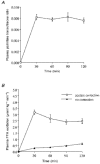Validation of the [1,2-13C]acetate recovery factor for correction of [U-13C]palmitate oxidation rates in humans
- PMID: 9782171
- PMCID: PMC2231259
- DOI: 10.1111/j.1469-7793.1998.215by.x
Validation of the [1,2-13C]acetate recovery factor for correction of [U-13C]palmitate oxidation rates in humans
Abstract
1. The validity of estimations of plasma fatty acid oxidation using tracers has often been questioned. The appearance of isotopic markers in breath CO2 is delayed and incomplete. Recently suggestions have been made that substantial amounts of tracer are incorporated into products of the tricarboxylic acid cycle (e.g. glucose, glutamine and glutamate) and that an acetate correction factor can be used to correct for tracer fixation. In the present study we investigated whether the appearance of 13CO2 during a separate infusion of [1,2-13C]acetate could be used for correction of [U-13C]palmitate oxidation rates in studies lasting <2 h and we quantified the appearance of tracer in the glutamine, glutamate and glucose pools of the body. 2. An infusion of either [1,2-13C]acetate (0.104 micromol min-1 kg-1) or [U-13C]palmitate (0.013 micromol min-1 kg-1) was given to eight male subjects and continued for 2 h at rest. In six subjects the infusion of [1,2-13C]acetate was repeated to determine reproducibility of the acetate recovery. 3. Fractional recovery in breath from [1,2-13C]acetate gradually increased during the infusion period at rest from 14.1 +/- 0.6% at 60 min to 26.5 +/- 0.5% at 120 min after the start of the infusion. Intersubject coefficient of variance was 8.3 +/- 0.6% and intrasubject coefficient of variance of the acetate recovery tests was 4.0 +/- 1.5%. After 2 h of [1,2-13C]acetate infusion, 12.4 +/- 0.8 and 10.3 +/- 0.9% of infused 13C was incorporated in the glutamine and glutamate pools, respectively. 4. In conclusion, the [1,2-13C]acetate recovery factor can be used for correcting the rate of [U-13C]palmitate oxidation in infusing studies of 2 h in resting conditions. Failure to use this recovery factor leads to a substantial underestimation of the rate of plasma free fatty acid oxidation. The extent of label fixation could largely be explained by accumulation of tracer carbon in glutamine and glutamate, and the accumulation in glucose is negligible.
Figures





References
-
- Beckers EJ, Halliday D, Wagenmakers AJM. Glucose metabolism and radioactive labeling: what are the real dangers? Medicine and Science in Sports and Exercise. 1994;26:1316–1318. - PubMed
-
- Bonadonna RC, Groop LC, Zych K, Shank M, DeFronzo RA. Dose-dependent effect of insulin on plasma free fatty acid turnover and oxidation in humans. American Journal of Physiology. 1990;259:E736–750. - PubMed
-
- Darmaun D, Matthews DE, Bier DM. Glutamine and glutamate kinetics in humans. American Journal of Physiology. 1986;251:E117–126. - PubMed
-
- Elia M, Schlatmann A, Goren A, Austin S. Amino acid metabolism in muscle and in the whole body of man before and after ingestion of a single mixed meal. American Journal of Clinical Nutrition. 1989;49:1203–1210. - PubMed
-
- Heiling VJ, Miles JM, Jensen MD. How valid are isotopic measurements of fatty acid oxidation? American Journal of Physiology. 1991;261:E572–577. - PubMed
Publication types
MeSH terms
Substances
LinkOut - more resources
Full Text Sources
Miscellaneous

